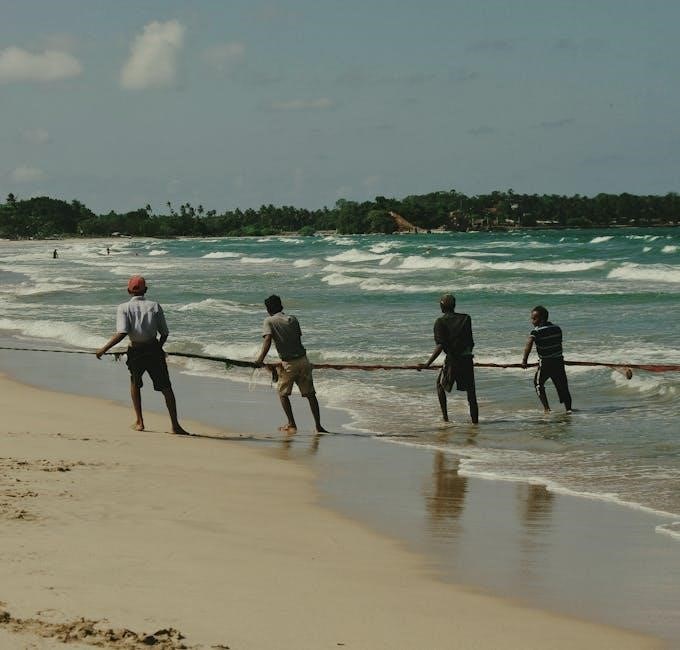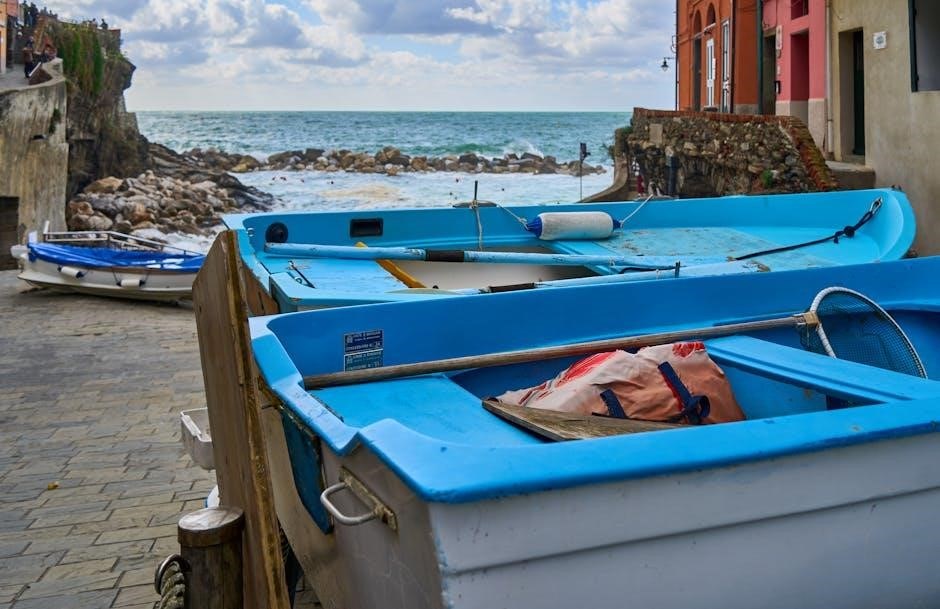Overview of VHF Marine Radio Channels
VHF marine radio channels are used for communication between ships and coast stations, with a total of 88 channels available, including 55 channels for voice communication and 33 channels for digital selective calling․ The channels are divided into several categories, including international, national, and local channels․ Each channel has a specific frequency and is used for a specific purpose, such as distress calling, navigation, or commercial communication․ The use of VHF marine radio channels is regulated by international and national authorities, and operators must follow strict guidelines to ensure safe and efficient communication․ The channels are also subject to interference and other technical limitations, which can affect their performance and reliability․ Overall, VHF marine radio channels play a critical role in maritime communication and safety․
U․S․ VHF Marine Radio Channels and Frequencies
U․S․ VHF marine radio channels and frequencies are regulated by FCC with specific rules always online now here for public use every day effectively․
Channel Allocation and Usage
Channel allocation and usage are critical components of VHF marine radio communication, with specific channels designated for different purposes, such as distress, safety, and general communication․ The Federal Communications Commission (FCC) regulates channel allocation in the United States, while international channels are governed by the International Telecommunication Union (ITU)․ Channel usage is also subject to rules and regulations, including the use of simplex and duplex channels, as well as the transmission of specific types of messages, such as Mayday and Pan-Pan calls․ Understanding channel allocation and usage is essential for safe and effective VHF marine radio communication, and is typically outlined in detailed charts and tables, such as those found in VHF marine frequencies PDF documents, which provide a comprehensive guide to channel allocation and usage․ Proper usage of channels ensures efficient communication․

International VHF Marine Radio Channels and Frequencies
International VHF marine radio channels and frequencies are standardized globally for safety and efficiency always using specific radio protocols online now here every day․
Global Channel Allocation and Usage
Global channel allocation and usage for VHF marine radio frequencies are managed by the International Telecommunication Union, ensuring standardized communication protocols worldwide․ The ITU allocates specific channels for various purposes, such as distress, safety, and navigation․ These channels are used by ships, coast stations, and other maritime services to communicate effectively․ The global channel allocation plan takes into account the needs of different regions and ensures that channels are used efficiently to minimize interference․ The plan is regularly updated to reflect changes in maritime communication needs and technological advancements․ Effective channel allocation and usage are critical for safe and efficient maritime communication, and the ITU plays a vital role in managing this process․ This ensures seamless communication across the globe, facilitating international maritime trade and safety․

VHF Marine Radio Equipment and Technology
Advanced VHF marine radio equipment and technology enhance communication systems with digital features every day online now here always effectively․
Types of VHF Marine Radios and Accessories
There are various types of VHF marine radios and accessories available, including handheld and fixed-mount models, with different features and functionalities․
Some radios come with built-in GPS, DSC, and AIS capabilities, while others may have additional features such as noise-cancelling microphones and loudspeakers․
Accessories like antennas, mounts, and cables are also essential for proper installation and operation of VHF marine radios․
Additionally, some radios may be compatible with other devices, such as chartplotters and fish finders, to enhance their functionality․
Overall, the type of VHF marine radio and accessories needed will depend on the specific requirements of the vessel and its intended use․
VHF marine radios and accessories play a crucial role in ensuring safe and effective communication at sea․
They are an essential part of any vessel’s communication system․

Marine VHF Radio Channels and Frequencies List
Marine VHF radio channels and frequencies list includes various tables and charts online now for reference and usage always effectively every day․
Solent Area VHF Marine Radio Frequency List
The Solent area VHF marine radio frequency list is a comprehensive guide to radio communication in the Solent area, including tables and charts of VHF frequencies․
The list provides information on simplex and duplex channels, as well as emergency and working channels․
It is an essential resource for mariners and coastal authorities, ensuring safe and effective communication in the region․
The frequency list is regularly updated to reflect changes in radio communication protocols and procedures․
It is available online and in print, making it easily accessible to those who need it․
The Solent area VHF marine radio frequency list plays a critical role in maintaining maritime safety and preventing accidents․
It is used by a wide range of stakeholders, including ship owners, operators, and regulatory agencies․
The list is also used in conjunction with other safety protocols and procedures․
Overall, the Solent area VHF marine radio frequency list is a vital tool for ensuring safe and effective radio communication in the Solent area․
It helps to prevent accidents and ensure compliance with regulatory requirements․
The list is an important part of maritime safety and should be consulted regularly by all mariners and coastal authorities․
It is a valuable resource that helps to promote safe and responsible use of VHF radio communication in the Solent area․
The frequency list is widely recognized as an essential tool for maritime safety and is used by mariners and coastal authorities around the world․
It provides a standardized system for radio communication, helping to prevent confusion and errors․
The Solent area VHF marine radio frequency list is a critical component of maritime safety and should be used in conjunction with other safety protocols and procedures․
It helps to ensure that radio communication is safe, effective, and compliant with regulatory requirements․
The list is regularly reviewed and updated to reflect changes in radio communication protocols and procedures․
It is an essential resource for mariners, coastal authorities, and regulatory agencies, and should be consulted regularly to ensure safe and effective radio communication in the Solent area․
The Solent area VHF marine radio frequency list is a vital tool for promoting maritime safety and preventing accidents․
It provides a standardized system for radio communication, helping to prevent confusion and errors, and ensuring that all stakeholders are aware of the correct frequencies to use in emergency and non-emergency situations․
The list is widely recognized as an essential tool for maritime safety and is used by mariners and coastal authorities around the world to ensure safe and effective radio communication․
It is a valuable resource that helps to promote safe and responsible use of VHF radio communication in the Solent area, and should be consulted regularly by all mariners and coastal authorities․
The frequency list is critical to ensuring maritime safety and preventing accidents, and should be used in conjunction with other safety protocols and procedures to ensure safe and effective radio communication in the Solent area․
It provides a standardized system for radio communication, helping to prevent confusion and errors, and ensuring that all stakeholders are aware of the correct frequencies to use in emergency and non-emergency situations, and is a vital tool for promoting maritime safety and preventing accidents․
The Solent area VHF marine radio frequency list is a comprehensive guide to radio communication in the Solent area․
It is an essential resource for mariners and coastal authorities, and should be consulted regularly to ensure safe and effective radio communication in the Solent area, and to prevent accidents and ensure compliance with regulatory requirements․
Overall, the Solent area VHF marine radio frequency list plays a critical role in maintaining maritime safety and preventing accidents, and is a vital tool for promoting safe and responsible use of VHF radio communication in the Solent area․
It is a valuable resource that helps to promote safe and responsible use of VHF radio communication, and should be consulted regularly by all mariners and coastal authorities to ensure safe and effective radio communication in the Solent area․
The list is widely recognized as an essential tool for maritime safety, and is used by mariners and coastal authorities around the world to ensure safe and effective radio communication, and to prevent accidents and ensure compliance with regulatory requirements․
It provides a standardized system for radio communication, helping to prevent confusion and errors, and ensuring that all stakeholders are aware of the correct frequencies to use in emergency and non-emergency situations, and is a critical component of maritime safety․
The Solent area VHF marine radio frequency list is a vital tool for promoting maritime safety and preventing accidents, and should be used in conjunction with other safety protocols and procedures to ensure safe and effective radio communication in the Solent area, and to prevent accidents and ensure compliance with regulatory requirements․
It is an essential resource for mariners, coastal authorities, and regulatory agencies, and should be consulted regularly to ensure safe and effective radio communication in the Solent area․
The frequency list is critical to ensuring maritime safety and preventing accidents, and should be used in conjunction with other safety protocols and procedures to ensure safe and effective radio communication in the Solent area, and to prevent accidents and ensure compliance with regulatory requirements․
It provides a standardized system for radio communication, helping to prevent confusion and errors, and ensuring that all stakeholders are aware of the correct frequencies to use in emergency and non-emergency situations․
The Solent area VHF marine radio frequency list is a comprehensive guide to radio communication in the Solent area, including tables and charts of VHF frequencies, and is an essential resource for mariners and coastal authorities․
It is used by a wide range of stakeholders, including ship owners, operators, and regulatory agencies, and is a vital tool for promoting maritime safety and preventing accidents․
The list is widely recognized as an essential tool for maritime safety, and is used by mariners and coastal authorities around the world to ensure safe and effective radio communication, and to prevent accidents and ensure compliance with regulatory requirements․
It provides a standardized system for radio communication, helping to prevent confusion and errors, and ensuring that all stakeholders are aware of the correct frequencies to use in emergency and non-emergency situations, and is a critical component of maritime safety, and should be consulted regularly by all mariners and coastal authorities to ensure safe and effective radio communication in the Solent area․
The Solent area VHF marine radio frequency list is a vital tool for promoting maritime safety and preventing accidents, and should be used in conjunction with other safety protocols and procedures to ensure safe and effective radio communication in the Solent area․
It is an essential resource for mariners, coastal authorities, and regulatory agencies, and should be consulted regularly to ensure safe and effective radio communication in the Solent area, and to prevent accidents and ensure compliance with regulatory requirements․
The frequency list is critical to ensuring maritime safety and preventing accidents, and should be used in conjunction with other safety protocols and procedures to ensure safe and effective radio communication in the Solent area․
It provides a standardized system for radio communication, helping to prevent confusion and errors, and ensuring that all stakeholders are aware of the correct frequencies to use in emergency and non-emergency situations, and is a vital tool for promoting maritime safety and preventing accidents, and should be consulted regularly by all mariners and coastal authorities to ensure safe and effective radio communication in the Solent area․
The Solent area VHF marine radio frequency list is a comprehensive guide to radio communication in the Solent area, including tables and charts of VHF frequencies, and is an essential resource for mariners and coastal authorities, and should be consulted regularly to ensure safe and effective radio communication in the Solent area․
It is used by a wide range of stakeholders, including ship owners, operators, and regulatory agencies, and is a vital tool for promoting maritime safety and preventing accidents, and should be used in conjunction with other safety protocols and procedures to ensure safe and effective radio communication in the Solent area․
The list is widely recognized as an essential tool for maritime safety, and is used by mariners and coastal authorities around the world to ensure safe and effective radio communication, and to prevent accidents and ensure compliance with regulatory requirements, and is a critical component of maritime safety․
The Solent area VHF marine radio frequency list is a vital tool for promoting maritime safety and preventing accidents, and should be used in conjunction with other safety protocols and procedures to ensure safe and effective radio communication in the Solent area, and to prevent accidents and ensure compliance with regulatory requirements, and is an essential resource for mariners, coastal authorities, and regulatory agencies․
It provides a standardized system for radio communication, helping to prevent confusion and errors, and ensuring that all stakeholders are aware of the correct frequencies to use in emergency and non-emergency situations, and is a critical component of maritime safety, and should be consulted regularly by all mariners and coastal authorities to ensure safe and effective radio communication in the Solent area, and to prevent accidents and ensure compliance with regulatory requirements․
The frequency list is critical to ensuring maritime safety and preventing accidents, and should be used in conjunction with other safety protocols and procedures to ensure safe and effective radio communication in the Solent area, and to prevent accidents and ensure compliance with regulatory requirements, and is a vital tool for promoting maritime safety and preventing accidents․
The Solent area VHF marine radio frequency list is a comprehensive guide to radio communication in the Solent area, including tables and charts of VHF frequencies, and is an essential resource for mariners and coastal authorities, and should be consulted regularly to ensure safe and effective radio communication in the Solent area, and to prevent accidents and ensure compliance with regulatory requirements․
It is used by a wide range of stakeholders, including ship owners, operators, and regulatory agencies, and is a vital tool for promoting maritime safety and preventing accidents, and should be used in conjunction with other safety protocols and procedures to ensure safe and effective radio communication in the Solent area․
The list is widely recognized as an essential tool for maritime safety, and is used by mariners and coastal authorities around the world to ensure safe and effective radio communication, and to

Importance of VHF Marine Radio Communication
VHF marine radio communication is crucial for safety and emergency situations at sea always requiring reliable equipment and protocols in place every time online․